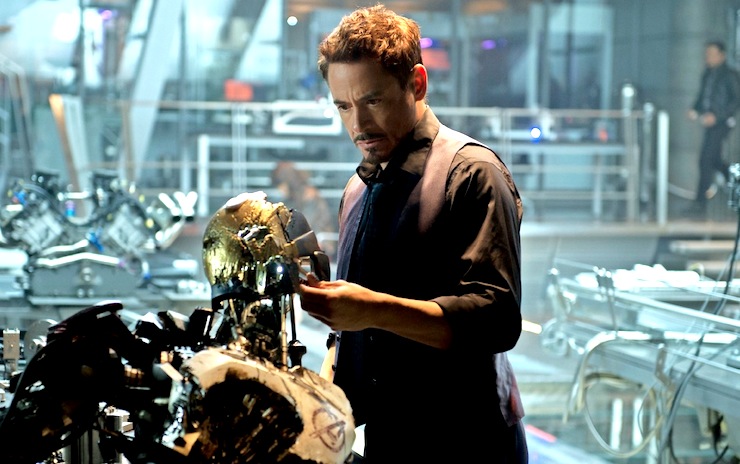Here’s the deal: We can talk about Avengers: Age of Ultron as a film, or we can talk about it as a piece of the Marvel Cinematic Universe jigsaw puzzle. As a film, it’s a fun action flick with some deeply hilarious plot contrivances. (It’s inevitable with these sorts of stories, really.) As the next step in the MCU arc, it is a joyful smash of all the things that you like in the same place.
See what I did there?
Spoilers for Avengers: Age of Ultron.
Sequels are hard. They’re hard mainly because the thing that you did the first time is no longer new. So when I see less-than-stellar reviews of this film, I’m hardly surprised. When The Avengers happened, no one had done what Marvel did, particularly in the vein of massive continuity soldering between a network of films. It was exciting. But because they’re just going to keep piling more stuff onto the super sundae, it’s only going to get more complex. If you’re not in these films for that specific purpose, Age of Ultron might not grab you.
It’s worth noting that Joss Whedon’s original cut of the movie was about an hour longer and had an alternate ending. That does account for places where the narrative clearly needed more explanation. Thor’s vision quest in the middle there, information on the Maximoff twins, a certain level of background and clarity is missing from the film. While the deleted scenes from The Avengers were best left on the cutting room floor, I wouldn’t be surprised if an extended cut for Ultron worked wonders toward restoring a more comprehensive tale.
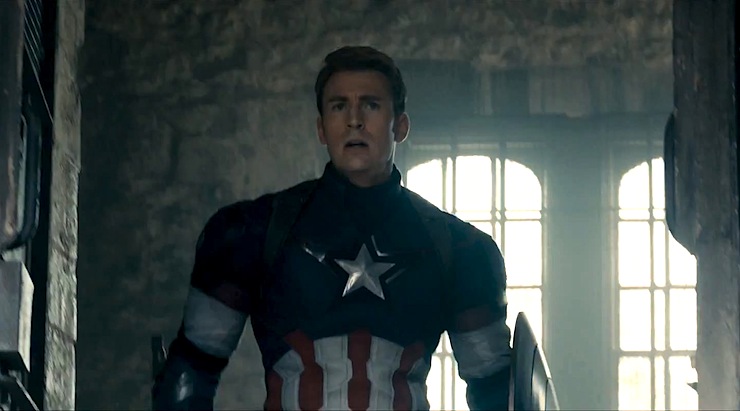
The opening sequence is really hard to throw stones at, though. The battle against Baron von Strucker’s forces feels like it’s right out of the pages of your favorite team-up comics. It’s pretty much everything we want from our crew—we see them working together seamlessly, bantering and ribbing each other, keeping each other safe. Everyone gets their moments to show why they’re the best at what they do, and the choreography is gorgeous. (Throw all the motorcycles at people, Cap!) They get their hands on Loki’s scepter, get introduced to those meddlesome Maximoff kids, and get out of dodge because Hawkeye got himself shot. (Aw, Clint. Of course you did.)
We find that the scepter contains one of the Infinity Stones, but J.A.R.V.I.S. perceives it as a sort of hyper-sophisticated computer. When Tony compares that “mind” with J.A.R.V.I.S.’, he’s blown away by its complexity and so is Bruce. Tony decides to take this model and lay it over his Ultron matrix—a peacekeeping program that would be applied to the Iron Legion drones. Of course, Tony is stepping up his plans in creating this and not including the team because Wanda messed with his brain and showed him a future where aliens are destroying the Earth and all his friends are dead. (All except Cap, who woefully calls out to Tony about how this is all his fault. Because even though Tony wants to pretend he doesn’t care about Cap all that much, we all know the sad, sad truth.)
Ultron manages to awaken while everyone’s partying and dispatches J.A.R.V.I.S., creating his own body. The character’s design is interesting, far more expressive than I went in expecting. James Spader does a killer job with what he’s given, and the result makes Ultron feel like a more legitimate threat than he might have. He’s got actual personality for a big bad villain, although it is overwritten at times.
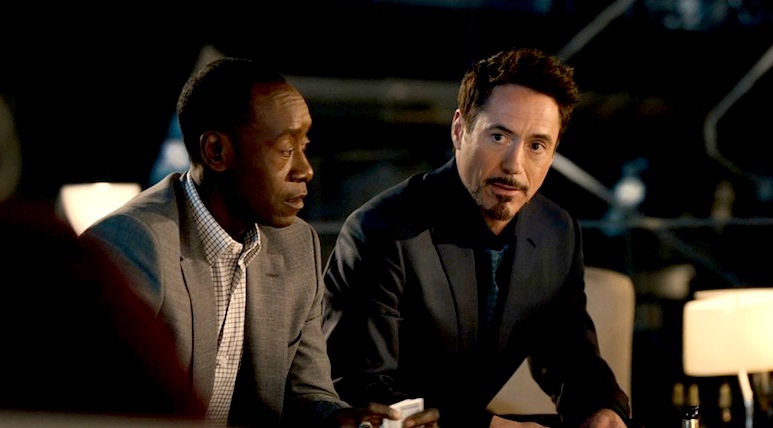
The party that he emerges into is really what you wish half of the movie could be, just teasing and drinking and all these characters being around each other as real people instead of archetypes. Thor and Tony argue about who has the better girlfriend. (Thor’s dialogue throughout this movie is half the reason it is enjoyable. He’s just perfect. He is a bundle of golden-retriever-like extreme weather patterns.) Rhodey tries to tell epic stories that do not impress his super friends. Sam lets Steve know that the trail is cold on the Winter Soldier front. Then the team hangs out after hours and all take their turns trying to lift Mjolnir. Bruce and Natasha have something of a heart-to-heart, and we see that Dr. Banner is about as good with advances as you’d expect for a guy who spends the majority of his time trying to avoid people.
So there’s an awesome thing about this movie that’s also an awkward thing about this movie. It does a great job at showing that the relationships we saw in The Avengers between this sprawling group of people have built up over time. Tony and Bruce—or Science Bros, as the fandom hath dubbed them—have a comfortable friendship and working rapport. The actual posturing between Steve and Tony has stepped down to posturing on pretense or for laughs. (Soon to become actual posturing again, since Civil War is coming.) Thor and Steve have a clear and easy dynamic; Clint is the snarky-but-beloved pain in the backside who everyone loves to needle; Maria Hill has stepped into the position of Home Base Operator, and everyone is clearly happy to have her there. What makes this awkward, of course, is not getting to see that in-between time when these bonds were being created. It leaves us with so many questions about how the team functions, how protocols were put into place, how certain decisions were made.
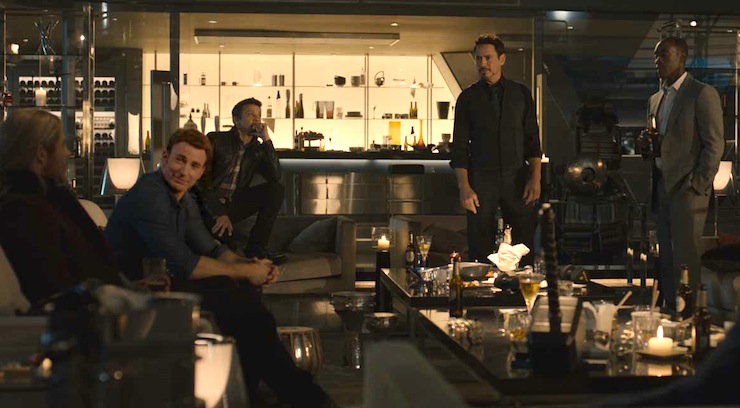
These questions are thrown into sharper relief when we consider the relationship that has formed between Bruce Banner and Natasha Romanov.
Now, there was already an understandable fan backlash that came during the Age of Ultron press tour when Jeremy Renner and Chris Evans flippantly called Black Widow’s character a “slut” and a “total whore” after a predictably trite interview question over Widow’s romantic ping-pong game in these films. Looking at it now (and I have to reiterate that those comments were still emphatically not cool), their cavalier attitude toward the question is interestingly situated—because Avengers: Age of Ultron makes it perfectly clear that, outside of Bruce Banner, Natasha has had no romantic attachments to any of these men whatsoever. Whedon basically retconned his own narrative in the first Avengers film, which distinctly implied romantic feelings between Widow and Hawkeye (helpfully supported by comics canon, where the two have been involved in the past).
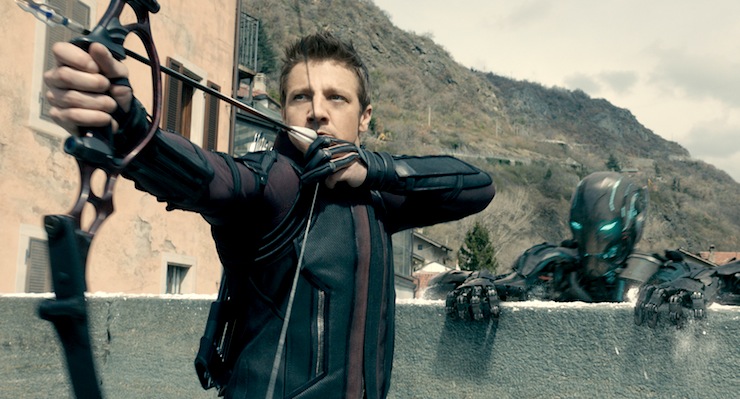
This new direction is handily exploited when Clint takes everyone to a safe house, following a pretty bad lose for the team in Wakanda, and we find out that not only does Hawkeye have a farm—he has a wife and two (soon-to-be-three) children. Which he kept from the Avengers. And S.H.I.E.L.D. In fact, it would seem that apart from Nick Fury and Natasha, no one knows about them at all. And because Clint explains that he set this up as a safe place for his family as soon as he joined S.H.I.E.L.D., we know that he has always been married as long as he’s known Natasha.
What that does is cast an entirely new light on Natasha’s actions toward saving Clint in the first Avengers film. At the beginning of Ultron, she refers to Clint as her “best friend,” and we now see that that’s precisely what they are to each other. The person they can lean on when the other gets banged up, the person who they can tell all of their secrets to. When Loki asks “Is this love, Agent Romanov?” and she brushes it aside, it’s because the “debt” that she owes him is a different kind. Clint is her family. His family is her family. She is not about to tell his wife, her friend, that she couldn’t bring Clint home.
Suddenly, you have to wonder whether that arrow necklace we saw Widow wearing in Captain America: Winter Soldier was a gift from Clint’s kids to their “Aunt Natasha.” (Are you weeping yet? You should be, I’ll feel less alone that way.) You have to wonder if that farm wasn’t the first place Clint took Natasha after recruiting her over to S.H.I.E.L.D. Someplace where she could try to heal and feel safe. And you begin to realize that Clint and Natasha’s relationship is much more akin to Steve and Bucky’s—a partner who you’re with ’til the end of the line.
Natasha and Steve are similarly situated, though obviously less close; for all that there were fans crying for them to pair up, nothing about their friendship in Winter Soldier really reads romantically—she spends the whole film trying to set him up with other women. Steve also admits in Ultron that he can tell the difference between Natasha flirting with people as it applies to her skill set and what she’s like when she is truly comfortable around someone. Which he says to indicate that she’s comfortable with Bruce, following that attempted heart-to-heart at the Tower Party.
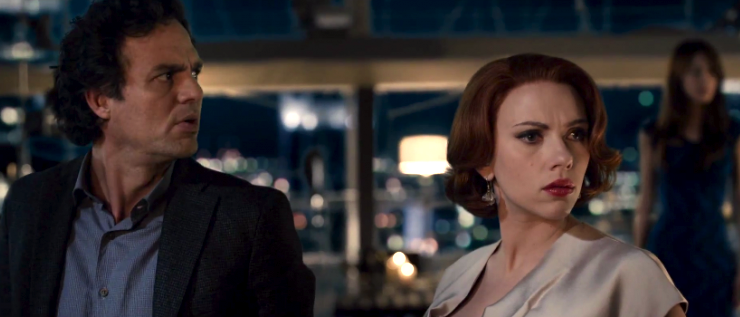
So the script of Ultron goes out of its way to show that Natasha is not bouncing from one romantic partner to another. And that actually makes sense with regard for what we know about her; it was really only after Winter Soldier that Natasha began to think of herself as anything but someone else’s tool. But she’s still struggling with it—in fact, she finds herself relating to Bruce because she sees a similarity between the two of them, both people who fear what they perceive to be a monster within themselves. It’s a wonderful flip of their relationship in The Avengers, which saw them each representing what the other feared most: for Widow, the unknown quantities that the world was being plunged toward (“monsters and magic and everything that we were never trained for”); for Hulk, the faceless organizations who sought to cage and control him.
Now they have arrived at a sort of détente: Natasha has become the person on the team responsible for “The Lullaby” (guessing Tony came up with that nickname, since he is the Nickname King). She approaches the Hulk and goes through a series of planned phrases and gestures that allow Bruce to focus and calm down enough to de-green. It seems likely that she was chosen for that particular duty as a way of building trust between the two of them on the team, but it’s such a shame that we don’t get more background on it. What we do know is that seeing more of Dr. Banner has changed Natasha’s attitude toward him significantly. But it’s relevant that while Bruce still cannot see the mixed blessing that the Hulk can be, Natasha is well aware of it. When he thinks of running in the final battle, Natasha triggers his transformation because she knows they need him. What’s interesting is that she is the only person who feels comfortable in removing that choice from him; everyone else on the team clearly has an understanding that Bruce only fights if he decides he’s going to fight.
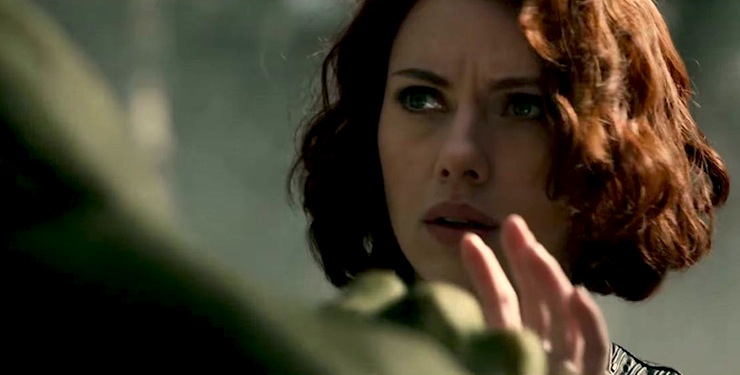
It’s important that Natasha—like Tony, Bruce’s closest friend on the team, and pointedly another person who sees value in the Hulk—knows that the Other Guy is needed because Bruce cannot see the subtlety of the green guy on his own. He doesn’t see the Hulk’s protective streak toward others, or indeed that the Hulk is guarding him. The Other Guy’s actions in this movie do nothing so much as confirm what Tony suggested in The Avengers; that the Hulk’s creation in that fateful gamma radiation accident is what saved Bruce’s life. When Wanda gets in the Hulk’s head, he terrorizes a Wakandan city, but when he comes to, he is clearly disturbed by his actions. It’s only when he sees weapons leveled at him that he starts to get angry again—because he perceives a threat. The same is true for his final actions in the film; it is poignant that the Hulk is the one who shuts Natasha out when she asks him to pilot the stealth ship back to the hellicarrier, not Bruce. The Hulk is protecting him, or at least means to do so.
The creation of Vision is another place where the film’s heart rests. Tony Stark is trying to put a suit of armor around the world, but he makes one dear mistake in calculating that trajectory; he still, after all this time, doesn’t trust himself. He creates Ultron out of ultimately alien technology, noting that its mind is far more advanced that what he has already created. But in favor of the science, he ignores the flesh and blood aspect, he ignores the goodness in himself and what he has already accomplished. J.A.R.V.I.S. may not be as advanced as Ultron, but he has everything that Tony has given him… among those characteristics are an appreciation of humanity, wonder, compassion, and kindness. That J.A.R.V.I.S. becomes the blueprint for Vision should surprise no one. All the things that made J.A.R.V.I.S. unique—laid across a more complex mental circuitry—create a being of tremendous power, but also provide the philosophical framework for a being who sees the value of benevolence. And… you’d have to. Taking care of Tony Stark all those years.
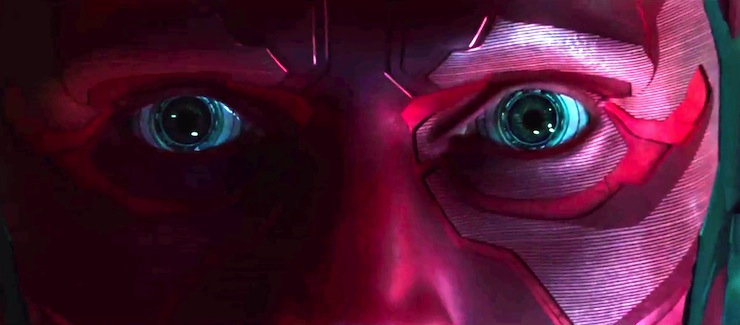
Tony and Steve can argue it all they want, but that’s ultimately what allows Vision the ability to lift the hammer. Which, I mean, I was pulling for it to be Widow, but if it couldn’t be her, that was basically the other best option. (And she never bothered to lift it anyway, so… I live in hope.) Also, can we talk about how the reason why Vision has a cape is to homage his other daddy, Thor? I mean, Tony and Bruce create Ultron together, but Vision is basically a three-parent process, and you’ve got to be tickled by the fact that he decides to honor it.
Captain America’s development is this film is markedly more subtle, but you can really see the seeds there of what’s coming in the Civil War arc. What Wanda manages to unearth for Steve (and Ultron smartly jibes at), deals with his inability to function outside of a battlefield, to know himself anywhere else. In the vision she reveals, Steve arrives for his dance with Peggy but the war is there on the floor (spilled red wine in the place of blood, flashbulbs from cameras in place of grenades), and the everything vanishes. By the end of the film, Steve is telling Tony that he wanted a home, a family, and quiet life like Clint’s before he went into the ice. But the guy who came out wants to stay here and train Avengers. And that’s surely going to affect him going forward.
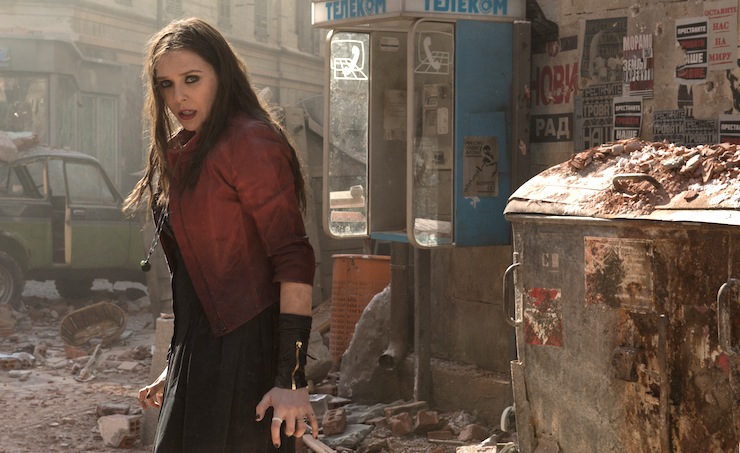
Poor Wanda and Pietro really don’t get much time to shine in this, and it’s unfortunate only for the fact that it squelches the impact of Quicksilver’s death. Whedon does his usual bait-and-swtich, telegraphing hard that Hawkeye is the one for the noose, but we’re landed with Pietro instead, and we don’t really know him well enough to feel the loss. We can glimpse some of it through Wanda, but her whole “I’m tearing out your heart” bit with Ultron is pretty contrived no matter how you cut it. At least we got Scarlet Witch out of the deal for future films—here’s hoping that she gets more to do, so we can really get the measure of her. Really not sure about those accents, though. Did they sound accurate to anyone? They seemed dodgy to me.
There are so many little bits and pieces here designed to shout out to the other movies, and a lot of them are wonderfully subtle. Except the hellicarrier. Everyone better get over it, we will never not have a hellicarrier available in the MCU, just get used to it now so it doesn’t bug you in the future. While some may not be pleased over Nick Fury’s role in things, it makes sense to me to have him around, perhaps moreso in an unofficial capacity. He’s the best person to tell everyone to dust off their boots and get back in the ring. Always. And he’s dead useful (get it? because people think he’s dead, haha, I’m the best) to have on the back burner because he knows literally EVERYONE and everyone basically loves him? So you know, Fury away.
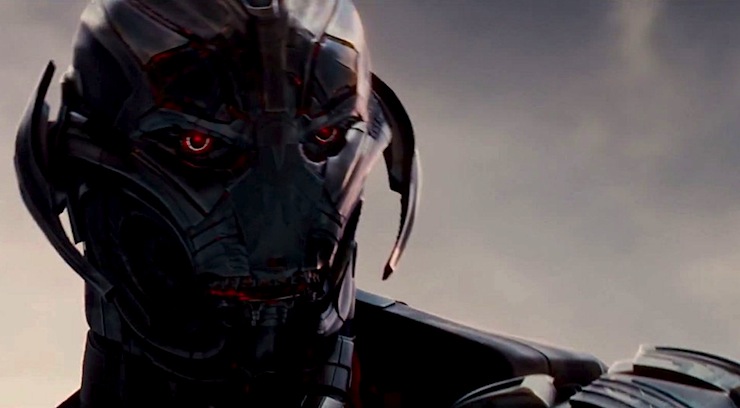
And with the departure of Thor (to deal with the coming Ragnarok) and Tony (to focus on things that don’t involve him taking responsibility for the entire world all the time—ahaha, as if) and Bruce (to be available wherever a Marvel movie has a Hulk-shaped hole), we get an image of what’s to come. Steve and Natasha (and probably Clint once baby Nathaniel Pietro Barton is less baby-like) training new recruits, and keeping the Avengers available to the world in a crisis. The new lineup features Scarlet Witch, Vision, War Machine, and Falcon—because that’s right, Sam Wilson said the Avengers was “Steve’s thing,” but you know when he got that call he was like IT’S ABOUT DAMN TIME LET ME FLY OVER IT’LL ONLY TAKE LIKE FIFTEEN MINUTES. This new team is beautiful. Who knows what’ll happen to them—fair to assume that by the time we hit Infinity War, everyone is going to be recalled and on the docket—but it’s just so exciting to see them.
So, you know, emotions? Teamwork? Funtimes? Really, it’s just a little distressing to know that Civil War is up next when most of the team seems to have arrived at a relatively stable place. But whatever its flaws, Age of Ultron is better than a roller coaster, and gives MCU fans plenty to chew on.
Emmet Asher-Perrin just really needed to walk by and high-five Steve when he told Sam that Brooklyn was too expensive for him to live in anymore because it means so much to her that Captain America knows this. You can bug her on Twitter and Tumblr, and read more of her work here and elsewhere.










